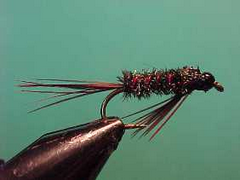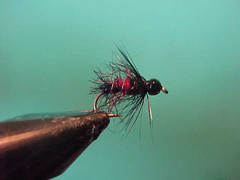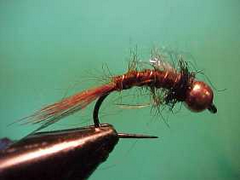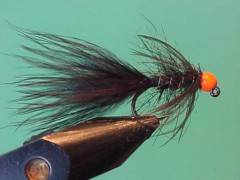Trout flies
{{start}}
{{end}}

{{+1}}Bead head diawl bach{{-1}}
{{start}}
I tie it both with and without weight and find the addition of a small black tungsten bead makes it a handy anchor fly or a good prospecting fly in running water.{{end}}

{{+1}}Bead head bibio variant{{-1}}
{{start}}
A bead head version is not a bad idea either. Swap over to a slightly longer hook such as a Tiemco 3769, start with a small black tungsten bead and continue with the recipe below. My version below varies from the original tie in that it doesn't include a body hackle. Instead the body is dubbed with seal fur dubbing which has been teased out in step 'D' with a Velcro rub.{{end}}

{{+1}}TBH chocolate caddis nymph{{-1}}
{{start}}
Caddis are are common throughout the year but with the greater concentrations occurring from September through to March. They inhabit both running and still water and are a significant food source for most trout often reputed to represent up to 30% of a trout's diet.{{end}}

{{+1}}Tarlington’s Corduliid (aka TC){{-1}}
{{start}}
I have fond memories of this fly from my early days of fly fishing. One of my favourite destinations was 'Frying Pan' which is the closest lake Eucumbene destination to Cooma where the TC was designed by Cooma resident Frank Tarlington. On one of those memorable trips to 'Frying Pan' I was introduced to one of the 'gun' regular fly fishers named Stan. When the mudeyes were on Stan would forgo all other flies and stick to a fly that he absolute confidence in , the TC. I have had a lot of respect for that fly ever since.{{end}}

{{+1}}Taihape tickler (aka Tie happy tickler){{-1}}
{{start}}
This fly is similar to a Craig's nightime but in my view has a wider day time application. The Craig's is highly respected as a night time fly when mudeyes are around whereas this fly works well in that situation but also more than holds its own during daylight hours during when either mudeyes or midge are around. Why it works when fish are on midge is any ones guess but it does.{{end}}

{{+1}}Claret hopper{{-1}}
{{start}}
A popular fly in the United Kingdom this fly is equally at home early and late in the season in Australia. We don't have any burgundy coloured hoppers that I am aware of but this buggy looking fly often works when the first and last of the seasons terrestrials are around. Whilst not a strong floater this fly ticks all the boxes for those that want an enticing fly that will sit in the surface film.{{end}}

{{+1}}Tea tree beetle – variant 2{{-1}}
{{start}}
Both floating and wet beetles (including drowned terrestrials beetles and aquatic beetles) should be fished in the current with as little line drag as possible or with a very short twitching action. A nondescript well tied beetle pattern if presented in the right way when fish have beetles on their menu, more often than not, will be accepted by fish.{{end}}

{{+1}}Tea tree beetle – variant 1{{-1}}
{{start}}
One species that is a popular food source for trout is the tea tree beetle. This representation is tied in shades of black and brown colours that have stood the test of time. Many of the recipes you see use brown raffia as the wing case. I don't like raffia as a fly tying material and have substituted a hackle from the back of the ring neck pheasant. Its a similar colour to many of the recipes that have come before mine but its much more durable than the raffia.{{end}}

{{+1}}Geehi beetle{{-1}}
{{start}}
One of the key elements of this fly that has been overlooked in many fly patterns I have seen id the choice of the front hackle. Make sure its a 'cocky-y-bonddu' type hackle i.e. a ginger hackle with a black centre. The black centre of the hackle when wound in touching turns to the eye of the hook extends the beetle body along the full length of the shank of the hook and I an confident that is one of the keys to the success of this fly.{{end}}

{{+1}}River Jig Bugger – CDC orange TBH and black{{-1}}
{{start}}
This is really good representation of a woolly bugger for river fishing. It sinks well and the jig hook encourages the fly to bounce along the bottom hook point up which of course mitigates snags. Whilst I have set the recipe out below for the brown, black and olive jig buggers I also tie my sparkle bugger and skirted buggers in the form of a jig bugger as shown in the photos below.{{end}}













